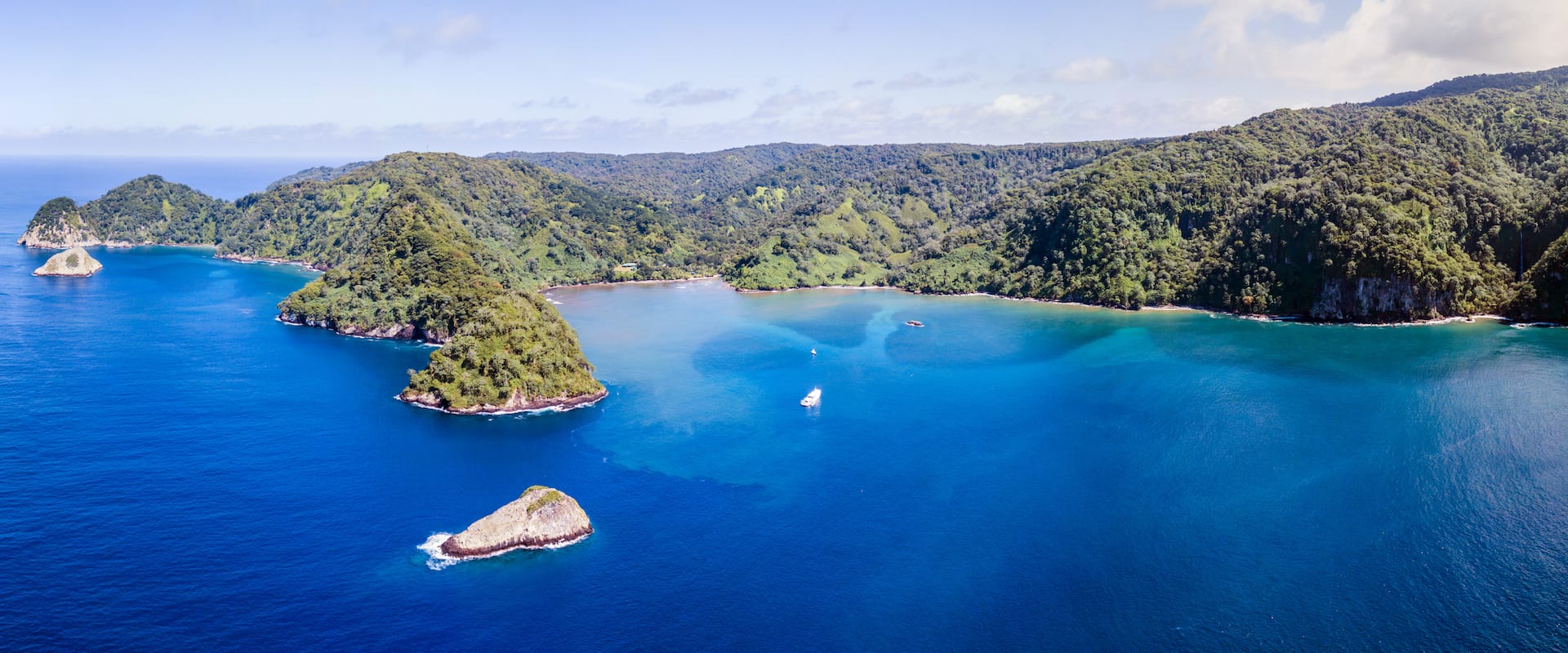Diving in Costa Rica
Divers choose scuba diving in Costa Rica on account of its excellent diversity of aquatic life. This Caribbean paradise offers the chance to see humpback whales, dolphins, orcas, turtles, hammerhead and bull sharks, manta rays and whale sharks. Cocos and Cano Island are firm liveaboard favourites.
Diving in Costa Rica is world class and attracts divers from all over the globe to explore the clear, nutrient-rich waters crammed with an impressive diversity of marine life swimming among volcanic rock formations and coral reefs. Costa Rica is one of the best places to see large schools of hammerheads and other sharks in their natural surroundings. At the heart of Central America, this compact country is an exceptional land bridge between two continents, bounded by the Pacific Ocean and the Caribbean Sea.
Legendary for its diversity of habitats, ranging from lush rainforest to hundreds of idyllic beaches, and rugged volcanoes to verdant mangroves, Costa Rica is a mecca for eco-tourism both above and below waves, with close to 4% of the Earth's total species in residence. Whilst diving along the Caribbean coast is still in its infancy, diving Costa Rica off the Pacific Coast is truly stunning. From the Bat Islands in Guanacaste Bay in the northwest to Cano Island in the south and the far-flung Cocos Island, divers are treated to underwater delights such as dolphins, turtles, hammerhead sharks, whale sharks and manta rays.
3 Liveaboards in Costa Rica
Explore all liveaboards
Okeanos Aggressor II
Costa Rica-
- from $ 436 / day
- 8.6 Fabulous
- 52reviews

Sea Hunter
Costa Rica-
- from $ 509 / day
- 9.1 Superb
- 37reviews

Cocos Island Aggressor
Costa Rica-
- from $ 476 / day
- 8.6 Fabulous
- 20reviews
Diving in Costa Rica FAQ
What marine life can I expect to see in Costa Rica?
Thanks to the plankton-rich waters that surround this equatorial country, diving Costa Rica offers a mind-blowing diversity of soft and hard corals, fish, invertebrates, turtles, sharks and even whales.
Six different species of sea turtles return to mate and nest along both the Pacific and Caribbean coasts of Costa Rica. This means that pretty much any time of year divers have the chance to encounter these adorable reptiles in the water.
More than twenty species of whales and dolphins are known to migrate through Costa Rican waters, including the eternally impressive humpbacks, orca and Pacific spotted dolphin. So on almost any dive, divers may be treated to a haunting underwater whale song or the squeaks and whistles of a dolphin pod while diving in Costa Rica, as different species head to the warm equatorial waters from their winter homes either in the northern or southern hemisphere.
The impressive abundance of Bull sharks from May to September among the Bat Islands attracts many to come diving in Costa Rica. During these rainy months, the ocean waters are often calmer and some people believe the runoff of rain brings these magnificent beasts closer to shore, as the only shark species with a tolerance for freshwater.
The warm water bursting with their microscopic food entices Giant Pacific Manta Rays and schools of their smaller relative, the Devil Rays to the islands of Costa Rica's northwest Pacific coast.
And if all that wasn't already enough, the biggest fish in the sea, the whale shark, also puts in an appearance at Costa Rica dive sites from May to August. Although these glorious creatures regularly grow up to almost 10 meters (33 feet) in length, they subsist almost exclusively on plankton and the occasional the small fish that suck up along the way.
What are the best dive sites in Costa Rica?
Although getting out to Cocos Island requires a lengthy boat trip some 550km (340miles) west across the Pacific, it is definitely worth the journey. A variety of Costa Rica liveaboards transport divers in style to explore this prolific remote sanctuary that boasts an incredible array of pelagic species including sharks, schooling hammerheads, rays and even whales.
Perhaps not as renowned as Cocos Island, but certainly towards the top of most divers' Costa Rican diving wish lists, Cano Island sits 10 miles (16 km) west of the Península de Osa on the southwest coast. Offering a wonderful assortment of dive sites for both seasoned veterans and novices alike, the clear waters of the Pacific are filled with a multitude of reef fish, sharks, mantas, and passing whales and dolphins which congregate around the pinnacles and coral reefs that border the island.
The province of Guanacaste on Costa Rica's northwest shoulder, bordered by Nicaragua in the north and the Nicoya Peninsula to the south, attracts of several species of sea turtles every year as they return home in the thousands, swimming through the waters of the Pacific to lay their precious eggs in the soft sandy beaches.
Nearby, the seas off the coast of the Santa Rosa National Park, the marine preserve of the Bat Islands (Islas Murcielago) literally teem with bull sharks from May to September, but at any time of year a kaleidoscope of colourful fish play among the submerged caverns and rock formations at the many varied dive spots around the islands.
Truly one of the best dive sites in Costa Rica, Bajo Alcyone seamount, sitting east of Cocos Island, is an immense underwater rock pinnacle, really more of a submerged mountain, offering unparalleled opportunities to hang out with literally hundreds of scalloped hammerhead sharks and seemingly infinite numbers of schooling tuna and jacks.At this famous dive spot, divers descend down the slope to around 25 - 30 meters (82 - 100 feet) to look for a somewhat sheltered location on the wall or a spot to hold on and watch the sharks swirling by.
What's the best time to dive in Costa Rica?
If you ask a local, they will likely tell you that it rains all year round, but warm, tropical showers do nothing to dampen the incredible scuba diving in Costa Rica any time of year, with air temperatures ranging from 27°C (82°F) in winter to 33°C (92°F) in summer.
Verano as it's known, December through April is officially considered the dry season, when most days are actually dry, but there's always a chance of rain. During the rainy, or "green" season, beginning in May, the mornings are typically clear before the rain moves in with the afternoon.
With 12 hours of sunlight every day of the year, and visibility at dive sites usually ranging 10-30 meters (30-100 feet) depending on the season (June to September generally offers the best viz), it’s really the marine life that dictates when to dive in Costa Rica.
Whale Sharks and Bull sharks can be found amid the Pacific waters during "winter" months (May - August), along with the arrival of migrating green turtles coming ashore to lay eggs in August and September. The end of the year brings the appearance of Manta Rays usually hanging around from November to May. Come January, migratory humpback and pilot whales can be spotted, being replaced as the creature of choice in April, when visitors are on the lookout for Leatherback turtles.
Water Temperatures generally run from 26-29°C (78-84°F), but can be rather cooler during the dry season, December through March (as low as 20°C/68°F), so along with a fair few thermoclines and cooler currents, most divers will want to bring either 3 or 5mm wetsuit along.
What's the recommended experience level for diving in Costa Rica?
To go scuba diving in Costa Rica you will be asked to show your certification card at any dive shop or resort, but throughout the country there are dive sites that are accessible to all levels of dive experience.
If you aren't already certified, not to worry, you have several options. You can just try it out with a discover dive (also known as a resort dive), offered by most dive operations; or you can go ahead and get your scuba diver or open water certification (entry-level certification) and come home from your vacation with more than just a tan.
How do I get to Costa Rica?
Most international flights arrive into the Juan Santamaria Airport (SJO), in the town of Alajuela about 17km (11 miles) northwest of the capital, San Jose, the perfect gateway for scuba diving either the Central Pacific or Caribbean coasts.
A number of US and Canadian airlines also now fly directly into the Daniel Oduber Airport (LIR) in Liberia, making travel around the northwestern Guanacaste region much more accessible.
For those divers heading out on a Costa Rica liveaboard dive trips, you'll then enjoy the two and half hour drive through sumptuous rainforest and abundant farmlands to the port of Puntarenas where you will begin your Costa Rica scuba diving adventure.
3 Liveaboards in Costa Rica
Explore all liveaboards
Okeanos Aggressor II
Costa Rica-
- from $ 436 / day
- 8.6 Fabulous
- 52reviews

Sea Hunter
Costa Rica-
- from $ 509 / day
- 9.1 Superb
- 37reviews

Cocos Island Aggressor
Costa Rica-
- from $ 476 / day
- 8.6 Fabulous
- 20reviews











